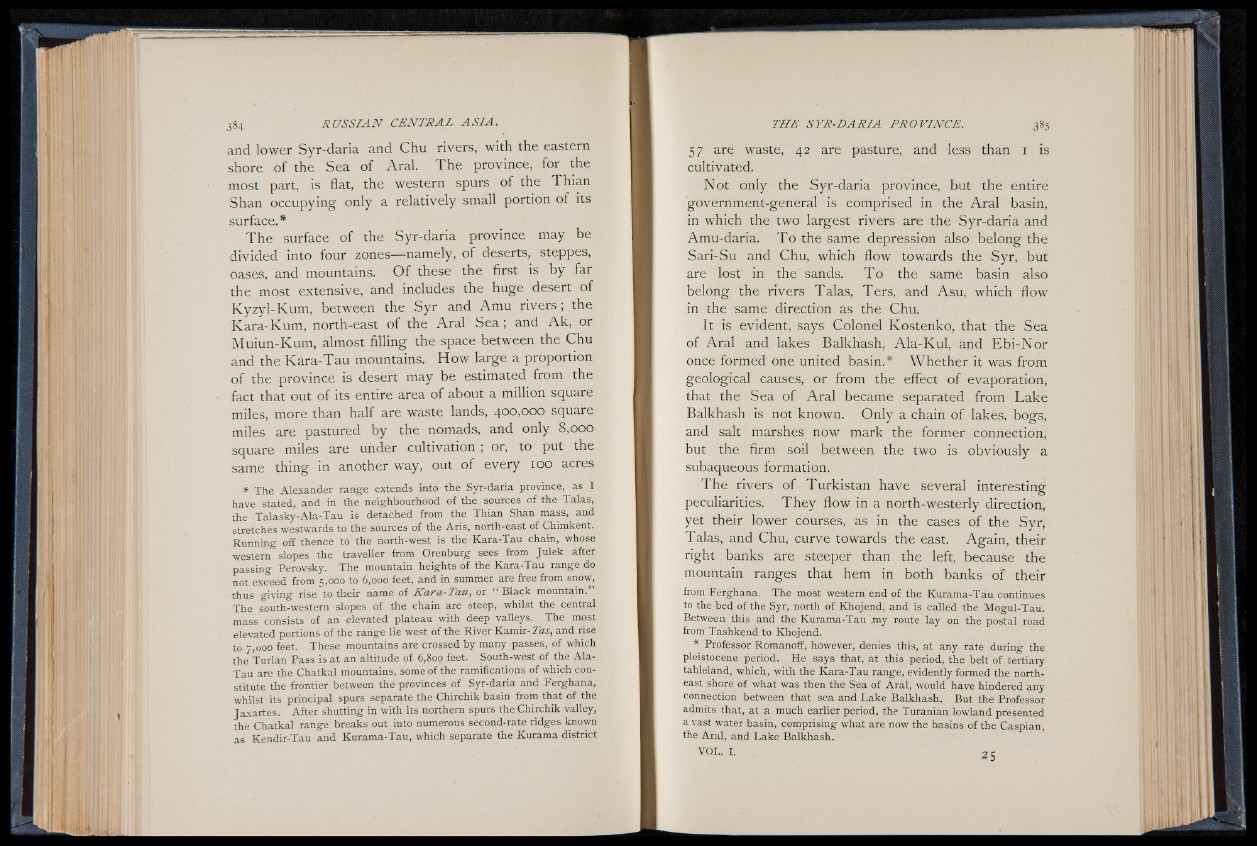
and lower Syr-daria and Chu rivers, with the eastern
shore of the Sea of Aral. The province, for the
most part, is flat, the western spurs of the Thian
Shan occupying only a relatively small portion of its
surface.*
The surface of the Syr-daria province may be
divided into four zones— namely, of deserts, steppes,
oases, and mountains. O f these the first is by far
the most extensive, and includes the huge desert of
Kyzyl-Kum, between the Syr and Amu rivers, the
Kara-Kum, north-east of the Aral Sea ; and Ak, or
Muiun-Kum, almost filling the space between the Chu
and the Kara-Tau mountains. How large a proportion
o f the province is desert may be estimated from the
fact that out of its entire area of about a million square
miles, more than half are waste lands, 400,000 square
miles are pastured by the nomads, and only 8,000
square miles are under cultivation ; or, to put the
same thing in another way, out . of every 100 acres
* The Alexander range extends into the Syr-daria province, as I
have stated, and in the neighbourhood of the sources of the Talas,
the Talasky-Ala-Tau is detached from the Thian Shan mass, and
stretches westwards to the sources of the Aris, north-east of Chimkent.
Running off thence to the north-west is the Kara-Tau chain, whose
western slopes the traveller from Orenburg sees from Julek after
passing Perovsky. The mountain heights of the Kara-Tau range do
not exceed from 5,000 to 6,000 feet, and in summer are free from snow,
thus giving rise to their name of Kara-Tau, or “ Black mountain.”
The south-western slopes of the chain are steep, whilst the central
mass consists of an elevated plateau with deep valleys. The most
elevated portions of the range lie west of the River Kamir-l'as, and rise
to 7,000 feet. These mountains are crossed by many passes, of which
the Turlan Pass is at an altitude of 6,800 feet. South-west of the Ala-
Tau are the Chatkal mountains, some of the ramifications of which constitute
the frontier between the provinces of Syr-daria and Ferghana,
whilst its principal spurs separate the Chirchik basin from that of the
Jaxartes. After shutting in with its northern spurs the Chirchik valley,
the Chatkal range breaks out into numerous second-rate ridges known
as Kendir-Tau and Kurama-Tau, which separate the Kurama district
57 are waste, 42 are pasture, and less than 1 is
cultivated.
Not only the Syr-daria province, but the entire
government-general is comprised in the Aral basin,
in which the two largest rivers are the Syr-daria'and
Amu-daria. T o the same depression also belong the
Sari-Su and Chu, which flow towards the Syr, but
are lost in the sands. T o the same basin also
belong the rivers Talas, Ters, and Asu, which flow
in the same direction as the Chu.
It is evident, says Colonel Kostenko, that the Sea
of Aral and lakes Balkhash, Ala-Kul, and Ebi-Nor
once formed one united basin.* Whether it was from
geological causes, or from the effect of evaporation,
that the Sea of Aral became separated from Lake
Balkhash is not known. Only a chain of lakes, bogs,
and salt marshes now mark the former connection,
but the firm soil between the two is obviously a
subaqueous formation.
The rivers of Turkistan have several interesting
peculiarities. They flow in a north-westerly direction,
yet their lower courses, as in the cases of the Syr,
Talas, and Chu, curve towards the east. Again, their
right banks are steeper than the left, because the
mountain ranges that hem in both banks of their
from Ferghana. The most western end of the Kurama-Tau continues
to the bed of the Syr, north of Khojend, and is called the Mogul-Tau.
Between this and the Kurama-Tau jn y route lay on the postal road
from Tashkend to Khojend.
* Professor Romanoff, however, denies this, at any rate during the
pleistocene period. He says that, at this period, the belt of tertiary
tableland, which, with the Kara-Tau range, evidently formed the northeast
shore of what was then the Sea of Aral, would have hindered any
connection between that sea and Lake Balkhash. But the Professor
admits that, at a much earlier period, the Turanian lowland presented
a vast water basin, comprising what are now the basins of the Caspian,
the Aral, and Lake Balkhash.
V O L . I . 2 5